
Miranda de Ebro
Encyclopedia
Miranda de Ebro is a city on the Ebro
river in the province of Burgos
in the autonomous community of Castile and León
, Spain. It is located in the north-eastern part of the province, on the border with the province of Álava
and the autonomous community of La Rioja. According to the 2008 census conducted by Spain's National Institute of Statistics (Instituto Nacional de Estadística
), it has a population of 39,589 inhabitants, making it the second most populous city in the province after the capital, Burgos
.
The city has an industrial economy focusing on the chemical industry. It is an important transportation hub, especially as a railroad junction. Within 80 kilometres (49.7 mi) are the cities of Bilbao
, Burgos
, Logroño
and Vitoria.
, 80 kilometres (49.7 mi) from the capital, in the autonomous community of Castile and León
(Spain). The coordinates of the city are: latitude 42º 41 ' 6 " N, longitude 2º 55 ' 60 " W; it has an area of 101.33 square kilometres (39.1 sq mi), a perimeter of 72312 metres (237,244.1 ft) and is 471 metres (1,545.3 ft) above sea level, according to the National Geographic Institute.
The city is divided into two parts by the river Ebro
. The old part is named Aquende and the new part is named Allende.
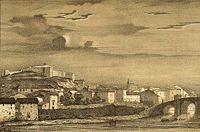 The first settlements in the area date from the Iron Age
The first settlements in the area date from the Iron Age
. The Roman
ruins of Arce are located only 3 kilometres (1.9 mi) from Miranda. There, according to the most recent studies, the Roman city of Deóbriga was built. Roman ruins are also found in the nearby municipalities of Cabriana and Puentelarrá.
The earliest mention of the name of Miranda de Ebro is in the Codex Vigilanus
, which describes the famous expedition that Alfonso I of Asturias
undertook in 757. This codex discusses destroyed localities, one of which was Miranda.
After the assassination of Sancho Garcés IV of Navarre
, Vizcaya, Álava, La Rioja and the royal family, Alfonso VI of Castile
and Leon was recognized as king. This event passed Miranda de Ebro into the hands of the Kingdom of Castile
in 1076. To consolidate his power, Alfonso VI granted the fuero
of Miranda de Ebro in 1099.
In 1254, Alfonso X of Castile
granted the "May fair", consolidating commerce, and in 1332 Alfonso XI of Castile
granted the "March fair". The possession of a bridge over the Ebro since at least the 10th century, together with the concession of the fuero, have made Miranda de Ebro a great commercial center in the region since ancient times. During the 14th and 15th centuries, and after the disputes between Peter of Castile and Henry of Trastámara, the town of Miranda would pass from hand to hand, first to the domain of Burgos, then to the Álava Hermandad
and ultimately once again to Burgos in 1493, where it has remained to the present day.
The arrival of the railway in 1862 marked the beginning of the industrial revolution in the city. The junction of the lines from Madrid
to Irun
and Castejón
to Bilbao
was at Miranda railway station, making it the most important rail junction in northern Spain.
In 1907, King Alfonso XIII granted City status to Miranda.
During the Civil War
, the city was the location of a Nationalist concentration camp that remained active until 1947, and was the last camp to close down. During its existence, it held more than 65,000 prisoners, both Spanish and foreign.
Since 1992, Vierzon
(France) has been the twin city of Miranda de Ebro. In 1999, a celebration to commemorate the Ninth Centenary of the Fuero of Miranda took place in the presence of Infanta Doña Cristina and her husband Don Iñaki de Urdangarín.
(PSOE). The People's Party (PP)
and the United Left Party (IU)
have minority representation. Another local party is Izquierda Mirandesa
.
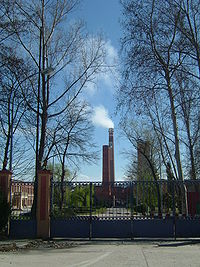 The primary sector is disappearing; nevertheless the cultivation of grain
The primary sector is disappearing; nevertheless the cultivation of grain
still remains the primary activity of the region. Others, like irrigated farming
and viticulture
, are of lesser importance. In the past cattle and horses were important as demonstrated by the fairs that have taken place since the 16th century in March and May. Mining also has its place; there are limestone
quarries on the outskirts of the city.
The secondary sector is developed thanks to its excellent geographic situation, next to the Basque Country
and La Rioja
, making Miranda de Ebro a city with a strong industrial and logistic character. The industrial revolution of the city began with the arrival of the railway in 1862. In the first half of the 20th century a sugar plant was the first big industry in the city (1925). Later on, FEFASA (1948) was created for the production of paper products. In the middle of the 20th century many chemical industries proliferated like Montefibre, ELF-Atochem, Rests, etc. The nuclear power station of Santa Maria de Garoña is located nearby.
In 1969 the first industrial estate of Bayas was conceived, but not until 1981 were various businesses established. It marked the beginning of many projects for the industrial and commercial development of the city. Other companies in the region produce food, aeronautical, iron and steel products.
Traditional commerce has made way for new enterprises for business and leisure. Companies like E.Leclerc, Inditex, Eroski, Mercadona and others have settled in the city. No commercial center exists and the commerce of Miranda is harmed due to the competition generated from nearby Vitoria.
The last data gathered by the INE (2008) indicate that Miranda de Ebro has a population of 39,586 inhabitants. After a gradual reduction of population during the 1990s, Miranda has gained inhabitants each year due in part to arrivals from neighboring Alava
in search of cheap housing. There has also been an increase in the immigrant population (10.8% of the total).
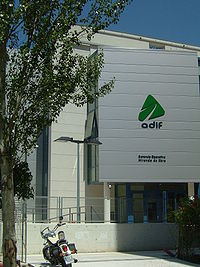 Its geographic location straddling the northern plateau of Ebro Valley and Basque territory makes Miranda de Ebro an important transportation hub, especially for rail traffic.
Its geographic location straddling the northern plateau of Ebro Valley and Basque territory makes Miranda de Ebro an important transportation hub, especially for rail traffic.
s), and motorways or freeways (autopista
s) pass through the city, connecting it with all the surrounding major cities. A project is underway to construct a new highway and a new freeway originating in the city. The first, A-68 or Autovía del Ebro (Ebro Highway), will connect Miranda to Aragón
via the Ebro valley. The second, AP-69 or Autopista Dos Mares (Two Seas Freeway), will connect Miranda to the Cantabria
n coastal plain via the Merindades
.
The Miranda de Ebro railway station is considered first class within the national rankings. Two lines, Madrid
–Irun
and Castejón
–Bilbao
, converge there. Since December 2007 the city has been connected to the main provincial capitals by the high-speed Alvia
service. It also possesses an important distribution hub in its Merchandise Classification and numerous RENFE
Red Nacional de los Ferrocarriles Españoles, Spanish National Railway Network shops. The ADIFAdministrador de Infraestructuras Ferroviarias, Railway Infrastructure Administration command post, which is in charge of traffic control for the whole of northern Spain, is located in Miranda's railway facilities.
The Miranda de Ebro bus terminal will be located on Railway Circle in the city centre, a few metres from the station. Construction is expected to start in 2009.
Although Miranda de Ebro has no airport of its own, Vitoria Airport
is located only 35 km away in Vitoria, which can be reached in under half an hour by the A-1 highway. Other airports near the city include Bilbao Airport
, Burgos Airport
, and Logroño-Agoncillo Airport
.
Miranda de Ebro also has its own fleet of taxis covering services to Vitoria and Plaza de la Estación. In recent years the city has been creating a network of bicycle lanes expected to extend 27 km and, since September 2008, the city has provided a bike rental service, Biciudad Miranda, similar to those of other major cities.
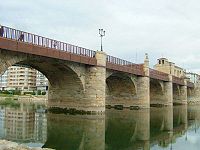
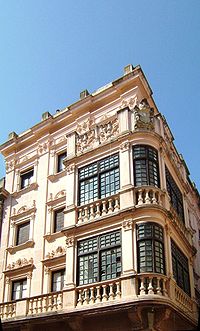
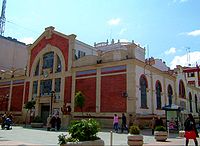
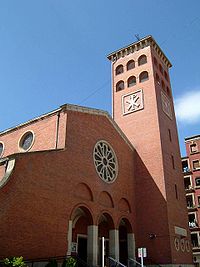
track, a motocross
track, and a model airplane field
.
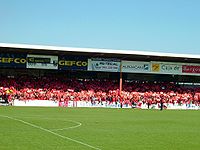
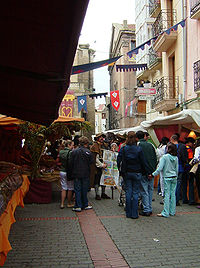 There are many celebrations and fairs held in Miranda de Ebro throughout the year. The first event of the year is the March Fair or Fair of the Angel, which is celebrated on 1 March and whose origin dates back to the 14th century. The first weekend of May is the May Fair, which has coincided since 1997 with the Medieval market.
There are many celebrations and fairs held in Miranda de Ebro throughout the year. The first event of the year is the March Fair or Fair of the Angel, which is celebrated on 1 March and whose origin dates back to the 14th century. The first weekend of May is the May Fair, which has coincided since 1997 with the Medieval market.
The main celebration in Miranda de Ebro is the Saint John of the Mountain Festival
, which is celebrated on the Whit Monday
. This celebration has a procession which is considered the best in Northern Spain. In addition, 12 September is the day of the city's patron, the Virgin of Altamira. This event contains float competitions, concerts and a firework display.
Ebro
The Ebro or Ebre is one of the most important rivers in the Iberian Peninsula. It is the biggest river by discharge volume in Spain.The Ebro flows through the following cities:*Reinosa in Cantabria.*Miranda de Ebro in Castile and León....
river in the province of Burgos
Burgos (province)
The province of Burgos is a province of northern Spain, in the northeastern part of the autonomous community of Castile and León. It is bordered by the provinces of Palencia, Cantabria, Vizcaya, Álava, La Rioja, Soria, Segovia, and Valladolid. Its capital is the city of Burgos...
in the autonomous community of Castile and León
Castile and León
Castile and León is an autonomous community in north-western Spain. It was so constituted in 1983 and it comprises the historical regions of León and Old Castile...
, Spain. It is located in the north-eastern part of the province, on the border with the province of Álava
Álava
Álava is a province of Spain and a historical territory of the Basque Country, heir of the ancient Lord of Álava. Its capital city is Vitoria-Gasteiz which is also the capital of the autonomous community...
and the autonomous community of La Rioja. According to the 2008 census conducted by Spain's National Institute of Statistics (Instituto Nacional de Estadística
Instituto Nacional de Estadística (Spain)
The National Institute of Statistics is the official organisation in Spain that collects statistics about demography, economy, and Spanish society. Every 10 years, this organisation conducts a national census. The last census took place in 2001....
), it has a population of 39,589 inhabitants, making it the second most populous city in the province after the capital, Burgos
Burgos
Burgos is a city of northern Spain, historic capital of Castile. It is situated at the edge of the central plateau, with about 178,966 inhabitants in the city proper and another 20,000 in its suburbs. It is the capital of the province of Burgos, in the autonomous community of Castile and León...
.
The city has an industrial economy focusing on the chemical industry. It is an important transportation hub, especially as a railroad junction. Within 80 kilometres (49.7 mi) are the cities of Bilbao
Bilbao
Bilbao ) is a Spanish municipality, capital of the province of Biscay, in the autonomous community of the Basque Country. With a population of 353,187 , it is the largest city of its autonomous community and the tenth largest in Spain...
, Burgos
Burgos
Burgos is a city of northern Spain, historic capital of Castile. It is situated at the edge of the central plateau, with about 178,966 inhabitants in the city proper and another 20,000 in its suburbs. It is the capital of the province of Burgos, in the autonomous community of Castile and León...
, Logroño
Logroño
Logroño is a city in northern Spain, on the Ebro River. It is the capital of the autonomous community of La Rioja, formerly known as La Rioja Province.The population of Logroño in 2008 was 153,736 and a metropolitan population of nearly 197,000 inhabitants...
and Vitoria.
Geography
The city of Miranda de Ebro is located in the northeastern part of the province of BurgosBurgos (province)
The province of Burgos is a province of northern Spain, in the northeastern part of the autonomous community of Castile and León. It is bordered by the provinces of Palencia, Cantabria, Vizcaya, Álava, La Rioja, Soria, Segovia, and Valladolid. Its capital is the city of Burgos...
, 80 kilometres (49.7 mi) from the capital, in the autonomous community of Castile and León
Castile and León
Castile and León is an autonomous community in north-western Spain. It was so constituted in 1983 and it comprises the historical regions of León and Old Castile...
(Spain). The coordinates of the city are: latitude 42º 41 ' 6 " N, longitude 2º 55 ' 60 " W; it has an area of 101.33 square kilometres (39.1 sq mi), a perimeter of 72312 metres (237,244.1 ft) and is 471 metres (1,545.3 ft) above sea level, according to the National Geographic Institute.
The city is divided into two parts by the river Ebro
Ebro
The Ebro or Ebre is one of the most important rivers in the Iberian Peninsula. It is the biggest river by discharge volume in Spain.The Ebro flows through the following cities:*Reinosa in Cantabria.*Miranda de Ebro in Castile and León....
. The old part is named Aquende and the new part is named Allende.
History

Iron Age
The Iron Age is the archaeological period generally occurring after the Bronze Age, marked by the prevalent use of iron. The early period of the age is characterized by the widespread use of iron or steel. The adoption of such material coincided with other changes in society, including differing...
. The Roman
Ancient Rome
Ancient Rome was a thriving civilization that grew on the Italian Peninsula as early as the 8th century BC. Located along the Mediterranean Sea and centered on the city of Rome, it expanded to one of the largest empires in the ancient world....
ruins of Arce are located only 3 kilometres (1.9 mi) from Miranda. There, according to the most recent studies, the Roman city of Deóbriga was built. Roman ruins are also found in the nearby municipalities of Cabriana and Puentelarrá.
The earliest mention of the name of Miranda de Ebro is in the Codex Vigilanus
Codex Vigilanus
The Codex Vigilanus or Códice Albeldense , full name Codex Conciliorum Albeldensis seu Vigilanus, is an illuminated compilation of various historical documents from the Visigothic period in Spain...
, which describes the famous expedition that Alfonso I of Asturias
Alfonso I of Asturias
Alfonso I , called the Catholic , was the King of Asturias from 739 to his death in 757.He was son of Duke Peter of Cantabria and held many lands in that region. He may have been the hereditary chief of the Basques, but this is uncertain...
undertook in 757. This codex discusses destroyed localities, one of which was Miranda.
After the assassination of Sancho Garcés IV of Navarre
Sancho IV of Navarre
Sancho IV Garcés , called Sancho of Peñalén or Sancho the Noble, was King of Navarre from 1054 to 1076. He was the eldest son and heir of García Sánchez III and Estefanía....
, Vizcaya, Álava, La Rioja and the royal family, Alfonso VI of Castile
Alfonso VI of Castile
Alfonso VI , nicknamed the Brave or the Valiant, was King of León from 1065, King of Castile and de facto King of Galicia from 1072, and self-proclaimed "Emperor of all Spain". After the conquest of Toledo he was also self-proclaimed victoriosissimo rege in Toleto, et in Hispania et Gallecia...
and Leon was recognized as king. This event passed Miranda de Ebro into the hands of the Kingdom of Castile
Kingdom of Castile
Kingdom of Castile was one of the medieval kingdoms of the Iberian Peninsula. It emerged as a political autonomous entity in the 9th century. It was called County of Castile and was held in vassalage from the Kingdom of León. Its name comes from the host of castles constructed in the region...
in 1076. To consolidate his power, Alfonso VI granted the fuero
Fuero
Fuero , Furs , Foro and Foru is a Spanish legal term and concept.The word comes from Latin forum, an open space used as market, tribunal and meeting place...
of Miranda de Ebro in 1099.
In 1254, Alfonso X of Castile
Alfonso X of Castile
Alfonso X was a Castilian monarch who ruled as the King of Castile, León and Galicia from 1252 until his death...
granted the "May fair", consolidating commerce, and in 1332 Alfonso XI of Castile
Alfonso XI of Castile
Alfonso XI was the king of Castile, León and Galicia.He was the son of Ferdinand IV of Castile and his wife Constance of Portugal. Upon his father's death in 1312, several disputes ensued over who would hold regency, which were resolved in 1313...
granted the "March fair". The possession of a bridge over the Ebro since at least the 10th century, together with the concession of the fuero, have made Miranda de Ebro a great commercial center in the region since ancient times. During the 14th and 15th centuries, and after the disputes between Peter of Castile and Henry of Trastámara, the town of Miranda would pass from hand to hand, first to the domain of Burgos, then to the Álava Hermandad
Hermandad
Hermandad, literally "brotherhood" in Spanish, was a peacekeeping association of armed individuals, which became characteristic of municipal life in medieval Spain, especially in Castile....
and ultimately once again to Burgos in 1493, where it has remained to the present day.
The arrival of the railway in 1862 marked the beginning of the industrial revolution in the city. The junction of the lines from Madrid
Madrid
Madrid is the capital and largest city of Spain. The population of the city is roughly 3.3 million and the entire population of the Madrid metropolitan area is calculated to be 6.271 million. It is the third largest city in the European Union, after London and Berlin, and its metropolitan...
to Irun
Irun
Irun is a town of the Bidasoa-Txingudi region in the province of Gipuzkoa in the Basque Autonomous Community, Spain...
and Castejón
Castejón
Castejón is a town and municipality located in the province and autonomous community of Navarre, northern Spain.Castejón is home to Spain's largest photovoltaic power plant , which opened in 2006 .-External links:*...
to Bilbao
Bilbao
Bilbao ) is a Spanish municipality, capital of the province of Biscay, in the autonomous community of the Basque Country. With a population of 353,187 , it is the largest city of its autonomous community and the tenth largest in Spain...
was at Miranda railway station, making it the most important rail junction in northern Spain.
In 1907, King Alfonso XIII granted City status to Miranda.
During the Civil War
Spanish Civil War
The Spanish Civil WarAlso known as The Crusade among Nationalists, the Fourth Carlist War among Carlists, and The Rebellion or Uprising among Republicans. was a major conflict fought in Spain from 17 July 1936 to 1 April 1939...
, the city was the location of a Nationalist concentration camp that remained active until 1947, and was the last camp to close down. During its existence, it held more than 65,000 prisoners, both Spanish and foreign.
Since 1992, Vierzon
Vierzon
Vierzon is a commune in the Cher department in the Centre region of France.-Geography:A medium-sized town by the banks of the Cher River with some light industry and an area of forestry and farming to the north...
(France) has been the twin city of Miranda de Ebro. In 1999, a celebration to commemorate the Ninth Centenary of the Fuero of Miranda took place in the presence of Infanta Doña Cristina and her husband Don Iñaki de Urdangarín.
Politics
The mayor of the city is Fernando Campo, member of the Spanish Socialist Workers' PartySpanish Socialist Workers' Party
The Spanish Socialist Workers' Party is a social-democratic political party in Spain. Its political position is Centre-left. The PSOE is the former ruling party of Spain, until beaten in the elections of November 2011 and the second oldest, exceeded only by the Partido Carlista, founded in...
(PSOE). The People's Party (PP)
People's Party (Spain)
The People's Party is a conservative political party in Spain.The People's Party was a re-foundation in 1989 of the People's Alliance , a party led and founded by Manuel Fraga Iribarne, a former Minister of Tourism during Francisco Franco's dictatorship...
and the United Left Party (IU)
United Left (Spain)
The United Left is a political coalition that was organized in 1986 bringing together several political organisations opposed to Spain joining NATO. It was formed by a number of groups of leftists, greens, left-wing socialists and republicans, but was dominated by the Communist Party of Spain...
have minority representation. Another local party is Izquierda Mirandesa
Izquierda Mirandesa
Izquierda Mirandesa is a Basque political party from the city of Miranda de Ebro .The actual leader of the party is Conchi Salazar.The ideology of the party is the left-wing Basque nationalism...
.
Economy and demographics

GRAIN
GRAIN is a small international non-profit organisation that works to support small farmers and social movements in their struggles for community-controlled and biodiversity-based food systems. Our support takes the form of independent research and analysis, networking at local, regional and...
still remains the primary activity of the region. Others, like irrigated farming
Irrigation
Irrigation may be defined as the science of artificial application of water to the land or soil. It is used to assist in the growing of agricultural crops, maintenance of landscapes, and revegetation of disturbed soils in dry areas and during periods of inadequate rainfall...
and viticulture
Viticulture
Viticulture is the science, production and study of grapes which deals with the series of events that occur in the vineyard. When the grapes are used for winemaking, it is also known as viniculture...
, are of lesser importance. In the past cattle and horses were important as demonstrated by the fairs that have taken place since the 16th century in March and May. Mining also has its place; there are limestone
Limestone
Limestone is a sedimentary rock composed largely of the minerals calcite and aragonite, which are different crystal forms of calcium carbonate . Many limestones are composed from skeletal fragments of marine organisms such as coral or foraminifera....
quarries on the outskirts of the city.
The secondary sector is developed thanks to its excellent geographic situation, next to the Basque Country
Basque Country (autonomous community)
The Basque Country is an autonomous community of northern Spain. It includes the Basque provinces of Álava, Biscay and Gipuzkoa, also called Historical Territories....
and La Rioja
La Rioja (Spain)
La Rioja is an autonomous community and a province of northern Spain. Its capital is Logroño. Other cities and towns in the province include Calahorra, Arnedo, Alfaro, Haro, Santo Domingo de la Calzada, and Nájera.-History:...
, making Miranda de Ebro a city with a strong industrial and logistic character. The industrial revolution of the city began with the arrival of the railway in 1862. In the first half of the 20th century a sugar plant was the first big industry in the city (1925). Later on, FEFASA (1948) was created for the production of paper products. In the middle of the 20th century many chemical industries proliferated like Montefibre, ELF-Atochem, Rests, etc. The nuclear power station of Santa Maria de Garoña is located nearby.
In 1969 the first industrial estate of Bayas was conceived, but not until 1981 were various businesses established. It marked the beginning of many projects for the industrial and commercial development of the city. Other companies in the region produce food, aeronautical, iron and steel products.
Traditional commerce has made way for new enterprises for business and leisure. Companies like E.Leclerc, Inditex, Eroski, Mercadona and others have settled in the city. No commercial center exists and the commerce of Miranda is harmed due to the competition generated from nearby Vitoria.
The last data gathered by the INE (2008) indicate that Miranda de Ebro has a population of 39,586 inhabitants. After a gradual reduction of population during the 1990s, Miranda has gained inhabitants each year due in part to arrivals from neighboring Alava
Álava
Álava is a province of Spain and a historical territory of the Basque Country, heir of the ancient Lord of Álava. Its capital city is Vitoria-Gasteiz which is also the capital of the autonomous community...
in search of cheap housing. There has also been an increase in the immigrant population (10.8% of the total).
Transport

Intercity transport
Numerous national roads, highways or dual carriageways (autovíaAutovía
An autovía is one of two classes of major highway in the Spanish road system similar to a motorway. It is akin to the autopista, the other major highway class, but has fewer features and is never a toll road. Some distinguishing features of an autovía are that it must be divided by a median, it...
s), and motorways or freeways (autopista
Autopista
Autopista refers to a controlled-access highway in various Spanish-speaking countries*Autopistas and autovías of Spain*Autopistas of Mexico*Autopistas of Puerto Rico*Autopistas of Chile...
s) pass through the city, connecting it with all the surrounding major cities. A project is underway to construct a new highway and a new freeway originating in the city. The first, A-68 or Autovía del Ebro (Ebro Highway), will connect Miranda to Aragón
Aragon
Aragon is a modern autonomous community in Spain, coextensive with the medieval Kingdom of Aragon. Located in northeastern Spain, the Aragonese autonomous community comprises three provinces : Huesca, Zaragoza, and Teruel. Its capital is Zaragoza...
via the Ebro valley. The second, AP-69 or Autopista Dos Mares (Two Seas Freeway), will connect Miranda to the Cantabria
Cantabria
Cantabria is a Spanish historical region and autonomous community with Santander as its capital city. It is bordered on the east by the Basque Autonomous Community , on the south by Castile and León , on the west by the Principality of Asturias, and on the north by the Cantabrian Sea.Cantabria...
n coastal plain via the Merindades
Merindades
Located in the north of the province of Burgos, the Merindades are the birth place of the name "Castilla". Most of the villages of the Merindades were quoted in the "Becerro de Behetrias" at the moment of the creation of the subdivision Merindad by Pedro of Castile.-See also:* Province of Burgos*...
.
The Miranda de Ebro railway station is considered first class within the national rankings. Two lines, Madrid
Madrid
Madrid is the capital and largest city of Spain. The population of the city is roughly 3.3 million and the entire population of the Madrid metropolitan area is calculated to be 6.271 million. It is the third largest city in the European Union, after London and Berlin, and its metropolitan...
–Irun
Irun
Irun is a town of the Bidasoa-Txingudi region in the province of Gipuzkoa in the Basque Autonomous Community, Spain...
and Castejón
Castejón
Castejón is a town and municipality located in the province and autonomous community of Navarre, northern Spain.Castejón is home to Spain's largest photovoltaic power plant , which opened in 2006 .-External links:*...
–Bilbao
Bilbao
Bilbao ) is a Spanish municipality, capital of the province of Biscay, in the autonomous community of the Basque Country. With a population of 353,187 , it is the largest city of its autonomous community and the tenth largest in Spain...
, converge there. Since December 2007 the city has been connected to the main provincial capitals by the high-speed Alvia
Alvia
Alvia is a high speed train in Spain used by RENFE for long distance service. The trains have the ability to use both Iberian gauge and standard gauge, which allows them to utilize the recently constructed high-speed lines for part of the journey before switching to the "classic" Iberian gauge...
service. It also possesses an important distribution hub in its Merchandise Classification and numerous RENFE
RENFE
Renfe Operadora is the state-owned company which operates freight and passenger trains on the 1668-mm "Iberian gauge" and 1435-mm "European gauge" networks of the Spanish national railway infrastructure company ADIF .- History :The name RENFE is derived from that of the former Spanish National...
Red Nacional de los Ferrocarriles Españoles, Spanish National Railway Network shops. The ADIFAdministrador de Infraestructuras Ferroviarias, Railway Infrastructure Administration command post, which is in charge of traffic control for the whole of northern Spain, is located in Miranda's railway facilities.
The Miranda de Ebro bus terminal will be located on Railway Circle in the city centre, a few metres from the station. Construction is expected to start in 2009.
Although Miranda de Ebro has no airport of its own, Vitoria Airport
Vitoria Airport
Vitoria Airport is an airport near Vitoria-Gasteiz, in the Basque Country of Spain.-Airlines and destinations:At the present, there aren't scheduled flights from VIT.-Cargo airlines:-External links:*...
is located only 35 km away in Vitoria, which can be reached in under half an hour by the A-1 highway. Other airports near the city include Bilbao Airport
Bilbao Airport
Bilbao Airport is a public airport located north of Bilbao, in the municipality of Loiu, in the Basque Country. It is the most important airport of the Basque Country and northern Spain, with 4,172,903 passengers on 2008...
, Burgos Airport
Burgos Airport
Burgos Airport , also known as Villafría, is an airport located west of the central business district of Burgos, a city in Spain.- History :...
, and Logroño-Agoncillo Airport
Logroño-Agoncillo Airport
Logroño-Agoncillo Airport is the airport serving Logroño in the autonomous community of La Rioja, Spain.This airport is located near Recajo village in the Agoncillo municipal term. It first opened as a military airport in 1923, when it was known as Aeródromo de Recajo...
.
Local transport
A fleet of buses operate a single route between the hospital and El Lago, though two new lines are expected in 2009.Miranda de Ebro also has its own fleet of taxis covering services to Vitoria and Plaza de la Estación. In recent years the city has been creating a network of bicycle lanes expected to extend 27 km and, since September 2008, the city has provided a bike rental service, Biciudad Miranda, similar to those of other major cities.
Civil structures



- Carlos III Bridge. Constructed in 1777 under the direction of Francisco Alejo of ArangurenArangurenAranguren is a town and municipality located in the province and autonomous community of Navarre, northern Spain.-External links:**...
, it consists of 6 arches and includes jettys at each end to reduce the impact of the waves. Since 1786 two lions have guarded the bridge, the work of sculptor Juan Antonio de Moraza; one of them clutches the royal shield and the other that of the city. - The present City Hall has stood in the Plaza de España since 1778. This building is also the work of Francisco Alejo of Aranguren and was modified by Ventura RodríguezVentura RodríguezVentura Rodríguez Tizón was a Spanish architect and artist. Born at Ciempozuelos, Rodríguez was the son of a bricklayer. In 1727, he collaborated with his father in the work at the Royal Palace of Aranjuez.-Major works:...
. The building is in the neoclassic styleNeoclassicismNeoclassicism is the name given to Western movements in the decorative and visual arts, literature, theatre, music, and architecture that draw inspiration from the "classical" art and culture of Ancient Greece or Ancient Rome...
, constructed of pillowed masonry blocks and finished with triangular and semicircular bays. - Castle of Miranda de EbroCastle of Miranda de EbroThe Castle of Miranda de Ebro is a medieval fortification located in Miranda de Ebro, Spain.-Location:The castle of Miranda de Ebro is located on the hill of the Picota, in the heart of the old helmet of the city...
, of which only a few walls remain. Built in the 14th century by Count Don Tello, it remained in operation until the Carlist WarsCarlist WarsThe Carlist Wars in Spain were the last major European civil wars in which contenders fought to establish their claim to a throne. Several times during the period from 1833 to 1876 the Carlists — followers of Infante Carlos and his descendants — rallied to the cry of "God, Country, and King" and...
of the nineteenth century. In the early twentieth century it was dismantled and filled in with earth, and many of its stones were used to build the now defunct bullfighting arena. - Several mansions dot the old town of Miranda de Ebro. The impressive House of Chains (Casa de las Cadenas) of the sixteenth century hosted Napoleon Bonaparte and King Ferdinand VII of Spain, who in 1828 inistalled the chains as a memento of their stay. Another remarkable building is the Urbina House (Casa de los Urbina), also of the sixteenth century, with its protruding defensive turrets. It hosted King Philip IV of SpainPhilip IV of SpainPhilip IV was King of Spain between 1621 and 1665, sovereign of the Spanish Netherlands, and King of Portugal until 1640...
on his journey to France, and Margarita of Savoy, Vicereine of Portugal, who died there in 1655. - Railway Station, built in 1862 by English architect Charles Vignoles, one of the oldest stations in northern Spain. It houses the junction of the MadridMadridMadrid is the capital and largest city of Spain. The population of the city is roughly 3.3 million and the entire population of the Madrid metropolitan area is calculated to be 6.271 million. It is the third largest city in the European Union, after London and Berlin, and its metropolitan...
–IrunIrunIrun is a town of the Bidasoa-Txingudi region in the province of Gipuzkoa in the Basque Autonomous Community, Spain...
and CastejónCastejónCastejón is a town and municipality located in the province and autonomous community of Navarre, northern Spain.Castejón is home to Spain's largest photovoltaic power plant , which opened in 2006 .-External links:*...
–BilbaoBilbaoBilbao ) is a Spanish municipality, capital of the province of Biscay, in the autonomous community of the Basque Country. With a population of 353,187 , it is the largest city of its autonomous community and the tenth largest in Spain...
lines. Its remarkable Victorian-style iron porticos were cast in London's Frederick Braby foundries. - Apollo Theatre, constructed in 1921; it was designed by RiojaRiojaRioja or La Rioja may refer to:Spain*Rioja, Almería*La Rioja , a province and autonomous community in northern Spain**Rioja , red and white wines from the province**La Rioja **University of La Rioja...
n architect Fermin Alamo. Its historicistHistoricism (art)Historicism refers to artistic styles that draw their inspiration from copying historic styles or artisans. After neo-classicism, which could itself be considered a historicist movement, the 19th century saw a new historicist phase marked by a return to a more ancient classicism, in particular in...
decorations, such as its busts erected on the windows and its ornamental plants, are outstanding. The adjoining building is in the same style and will be joined to the theater after renovation. - La Picota. Sculpted in 1569 by local master Maese Miguel Aguirre, this is the village rollo, a stone pillar symbolizing judicial power in times past.
- Plaza de Abastos, dedicated in 1917 in the heart of the city. Noted for its solidness of construction and authentic Islamic appointments.
- Old Convent of the Three Kings Augustinian RecollectsAugustinian Recollects-History:The Order of Augustinian Recollects or simply the Augustinian Recollects are a Roman Catholic mendicant Catholic religious order of friars and nuns. They are a reformist offshoot from the Augustinian hermit friars and follow the same Rule of St...
. In 1911 the Troconiz family built a northern style chalet, later selling it to Three Kings Augustinian Recollects, who in 1950 extended it with a chapelChapelA chapel is a building used by Christians as a place of fellowship and worship. It may be part of a larger structure or complex, such as a church, college, hospital, palace, prison or funeral home, located on board a military or commercial ship, or it may be an entirely free-standing building,...
of similar style. It features a pyramidal tower and pillowed stone façade. It has belonged to the Government of Castile and LeónCastile and LeónCastile and León is an autonomous community in north-western Spain. It was so constituted in 1983 and it comprises the historical regions of León and Old Castile...
since 1998.
Religious structures

- Church of the Holy Spirit. Known in antiquity under the name of its patron Saint Nicholas, this Roman-style temple is mentioned in the 1099 Miranda Charter. Its façade and apseApseIn architecture, the apse is a semicircular recess covered with a hemispherical vault or semi-dome...
date from the 13th century, and its small GothicGothic architectureGothic architecture is a style of architecture that flourished during the high and late medieval period. It evolved from Romanesque architecture and was succeeded by Renaissance architecture....
naveNaveIn Romanesque and Gothic Christian abbey, cathedral basilica and church architecture, the nave is the central approach to the high altar, the main body of the church. "Nave" was probably suggested by the keel shape of its vaulting...
from the sixteenth. It suffered major damage before the civil warSpanish Civil WarThe Spanish Civil WarAlso known as The Crusade among Nationalists, the Fourth Carlist War among Carlists, and The Rebellion or Uprising among Republicans. was a major conflict fought in Spain from 17 July 1936 to 1 April 1939...
(May 1936), and has been called by its present name since being renovated. - Saint Mary's Church, built in the 16th century in Late Gothic-RenaissanceRenaissanceThe Renaissance was a cultural movement that spanned roughly the 14th to the 17th century, beginning in Italy in the Late Middle Ages and later spreading to the rest of Europe. The term is also used more loosely to refer to the historical era, but since the changes of the Renaissance were not...
. In its interior lies the mummified body of Pascual Martinez, known as "El Chantre" ("The Cantor"). - Church of the Sacred Hearts. Located in the historic convent of San Francisco, the church was built in the sixteenth century. It is noted for its baroque-style steepleSteeple (architecture)A steeple, in architecture, is a tall tower on a building, often topped by a spire. Steeples are very common on Christian churches and cathedrals and the use of the term generally connotes a religious structure...
, built in 1693. - Old Church of Saint John, in ruins since 1875. Nevertheless, in its interior are preserved the principal naves decorated in colors, the baptismal font, and the compound ogiveOgiveAn ogive is the roundly tapered end of a two-dimensional or three-dimensional object.-Applied physical science and engineering:In ballistics or aerodynamics, an ogive is a pointed, curved surface mainly used to form the approximately streamlined nose of a bullet or other projectile.The traditional...
windows. - St. Nicholas's Church. Built in 1945, its construction project came in second in the National Architecture Competition that year. It includes three basilica-type naves, an apse, and a large rose windowRose windowA Rose window is often used as a generic term applied to a circular window, but is especially used for those found in churches of the Gothic architectural style and being divided into segments by stone mullions and tracery...
in its façade. Its interior features large tapestries painted by Manuel Navarro and his brother, hung from the apse wall.
Parks and gardens
Miranda de Ebro has not historically been known for having many areas of greenery within the city, but in recent years a series of parks and gardens have been created to correct this shortcoming. In January 2009 the city had 646,377 square meters of green areas, amounting to 16.35 square meters per inhabitant.- Antonio Machado Park, built in 1915, is the centermost park in Miranda de Ebro and has an area of 12,500 square meters. The park combines two very different styles: While its central crossing, with its embankments and wide paths, is clearly of French style the four gardens in its corners stand out for their stately tall trees and great expanses of lawn typical of English parks. In 1927 a kioskKioskKiosk is a small, separated garden pavilion open on some or all sides. Kiosks were common in Persia, India, Pakistan, and in the Ottoman Empire from the 13th century onward...
was erected in the middle of the park, which three years later would be covered with a cupolaCupolaIn architecture, a cupola is a small, most-often dome-like, structure on top of a building. Often used to provide a lookout or to admit light and air, it usually crowns a larger roof or dome....
designed by Fermin Alamo. Also found in the park are monuments to the Municipal Band, to Francisco Cantera, and to the ninth centennial of the Miranda Charter. - Miranda de Ebro Botanical Garden, adjacent to the old convent of the Servants of Jesus in the historical district, covers some 2,400 square meters of terraces on the slopes of La Picota. The garden houses 700 distinct species identified by common name, scientific name, variety, family, and place of origin.
Sports
The town of Miranda de Ebro features most of its sports facilities in Anduva Municipal MultiSports (Polideportivo Municipal de Anduva), which contains tennis courts, a covered court, a heated pool, outdoor pools, multi-sport fields, a gymnasium, a running track, and soccer pitches with both natural and artificial grass. Other sporting facilities in the city include Anduva Municipal Stadium (Estadio Municipal de Anduva) (soccer), La Charca facility, Jose Garcia facility, the Multifunction Pavilion, and the Ebro Pavilion. The city also has a kart racingKart racing
Kart racing or karting is a variant of open-wheel motorsport with small, open, four-wheeled vehicles called karts, go-karts, or gearbox/shifter karts depending on the design. They are usually raced on scaled-down circuits...
track, a motocross
Motocross
Motocross is a form of motorcycle sport or all-terrain vehicle racing held on enclosed off road circuits. It evolved from trials, and was called scrambles, and later motocross, combining the French moto with cross-country...
track, and a model airplane field
Model airplane field
Model airplane fields are used for landings and takeoffs of model aircraft.Facilities provided vary significantly. They range from unimproved fields to paved runways....
.
Sports clubs

- Club Deportivo MirandésCD MirandésClub Deportivo Mirandés is a Spanish football team based in Miranda de Ebro, Province of Burgos, in the autonomous community of Castile and León...
(or simply "Mirandés") is an association football team founded in 1927. Mirandes primarily competes in the Spanish third divisionTercera DivisiónTercera División is the fourth level of the Spanish football league system. The top three are the Primera División, often referred to as "La Liga" in English, the Segunda División, and Segunda División B.-Current Format:...
and has its home ground at the Anduva Municipal Stadium. Its supporters are known as the "marea rojilla", or "red tide". - Club Voley Miranda is a volleyballVolleyballVolleyball is a team sport in which two teams of six players are separated by a net. Each team tries to score points by grounding a ball on the other team's court under organized rules.The complete rules are extensive...
club that currently competes in the Women's Superleague 2.
Celebrations and events

The main celebration in Miranda de Ebro is the Saint John of the Mountain Festival
Saint John of the Mountain Festival
Saint John of the Mountain Festival is a festival in the town of Miranda de Ebro in the autonomuos community of Castile and León, in Spain. It is celebrated the Monday of Pentecost an it is the second most important romeria in Spain behind El Rocío....
, which is celebrated on the Whit Monday
Whit Monday
Whit Monday or Pentecost Monday is the holiday celebrated the day after Pentecost, a movable feast in the Christian calendar. It is movable because it is determined by the date of Easter....
. This celebration has a procession which is considered the best in Northern Spain. In addition, 12 September is the day of the city's patron, the Virgin of Altamira. This event contains float competitions, concerts and a firework display.

